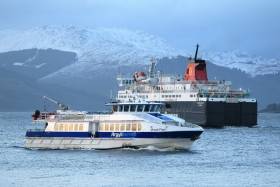Displaying items by tag: Former Aran Islands ferry
Urgent Calls to Remove At Risk Capsized Former Aran Islands Ferry from Dublin Dry-Dock
There have been calls to "urgently remove" a capsized former Galway-Aran Islands passenger and freight ferry that was left to rot in a Dublin dry-dock reports Dublin Live.
As Afloat reported earlier the veteran vessel had taken in water ingress during the recent cold snap.
The historic Naomh Eanna, which was withdrawn from the CIÉ operated Galway Docks-Aran Islands route 37 years ago, has been deemed a "risk" by an expert. The ship built in 1958 at the Liffey Dockyard, has languished for decades in the Grand Canal Basin and then moved to a nearby Georgian-era dry dock followed by acampaign to save the heritage deemed ship from scrapping almost a decade ago.
The ship of rivetted hull construction was the main mode of transport to the Aran Islands before being taken out of commission in 1988 and returned to the capital initially Afloat adds to Alexandra Basin, where the Liffey Dockyard was located. According to Inland Waterways Association of Ireland spokesman Reg MaCabe, the ship is an eyesore and needs to be "dealt with as a matter of urgency".
Speaking to RTE News he said: "I think at this stage, the prospect for renovating the ship is extremely limited...I would say any reasonable person would say it's time for it to be removed." The vessel in 2015 was for €1 bought by Sam Field-Corbett of the Irish Ship and Barge Fabrication (ISBF) which was also responsible for restoring the Liffey Dockyard built Cill Airne, which had a long career within Cork Harbour before its current Dublin based restaurant and bar venue roles.
In 2018 there were plans by Mr Field-Corbett to convert Naomh Eanna in a €6.6 million project of a five-star luxury hotel complete with a glazed restaurant on the boat deck, however the plan fell through (likewise to bring ship back to Galway). He said a salvage company had visited the ship in an attempt to shore up the vessel and limit damage to the dry-dock.
He added that the ship may have been scuppered by vandals.
The Naomh Eanna is berthed in one of two dry-docks within lands leased by the National Asset Management Agency (NAMA) who said the ISBF remains solely responsible for the ship and its maintenance.
Former Aran Islands Ferry Part of Scottish Route Transfer To CalMac
#ferry - The Scottish ferryroute Gourock to Dunoon on the Clyde will transfer to CalMac when the current contract ends next month, becoming part of the Clyde and Hebrides Ferry Services network.
As InverclydeNow writes, from 21 January, CalMac will provide the passenger-only service, in line with the current timetable arrangements. Transport Scotland say consideration will be given to improved harbour facilities for passengers.
Discussions will also be held regarding possible introduction of electric vehicle and electric bike hubs at both ferry terminals, as well as developing the ferry service to encourage active travel users.
The route is currently operated by Argyll Ferries, using the passenger-only craft Argyll Flyer and Ali Cat. Argyll Ferries was set up on 2011 as part of David McBrayne Ltd, the parent company of Caledonian MacBrayne, to bid for the Gourock/Dunoon contract.
Further details on the transfer of the south-west Scottish service, click here.
In addition Afloat coverage click here about Aran/Arran related ferries, past, present and future, noting a pair CalMac newbuilds, one for the Arran service, albeit is much delayed.
























































